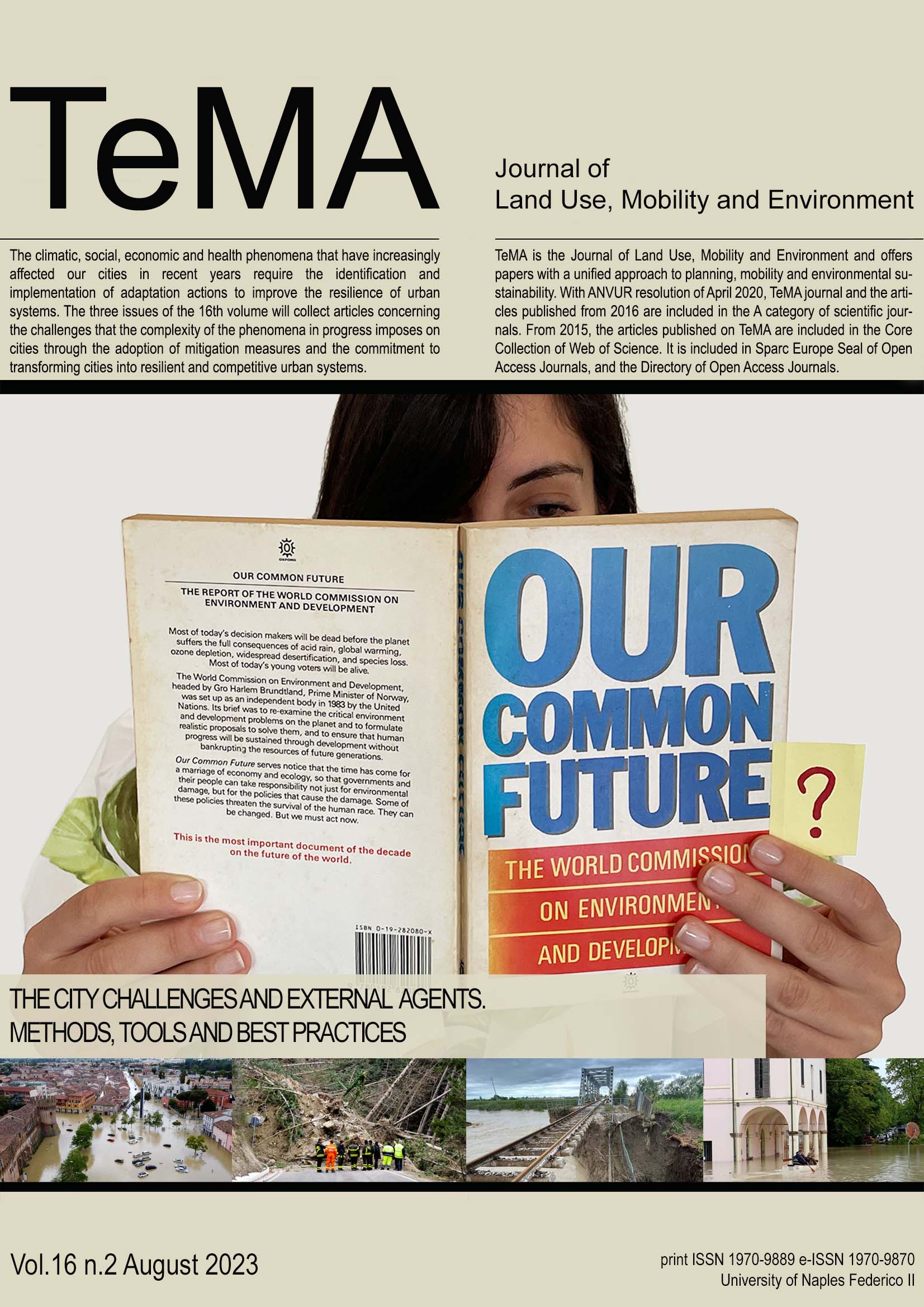Sustainable mobility for urban regeneration
NRRP, sustainability certifications in Albisola
Abstract
The choice of the mobility system is very topical today because it determines how the territories will develop in the years to come, which infrastructures will have to be built and which lifestyles will take shape in the cities of the future. The research presented in the paper starts from the study of sustainable mobility and the analysis of virtuous cases. From this study, a methodological approach was defined which identifies the main phases to follow and the aspects to pay attention in order to achieve a sustainable regeneration of the territory starting from the proposition of sustainable mobility projects. This approach also proposes a method and instrument for assessing the level of sustainability in line with the principle “Do No Significant Harm” presented in the National Recovery and Resilience Plan. The priorities aspect introduced concerns the integration of the quadruple helix concept, for a multi-stakeholder governance and sustainable regeneration. The illustrated research involves in fact four actors: it starts from a call for proposals carried out within the Genoa University, promoted by the Municipality of Albisola Superiore, in Liguria region, and sees the collaboration of the R2M Solution company and citizens.
Downloads
References
Battaglia, C. (2021). La ciclabilità per la rigenerazione urbana. Dalla Ciclovia Tirrenica ad Albisola Superiore, Degree thesis Advisors: Pirlone, F. Spadaro, I. D., Co-advisor: Erriu, D., Università degli Studi di Genova.
Bull, J.W., Gordon, A., Watson, J.E.M., Maron, M., 2016. Seeking convergence on the key concepts in "no net loss' policy. J Appl Ecol 53, 1686-1693.
Carayannis, E.G. & Campbell, D.F.J. (2009). Toward a 21st century fractal innovation ecosystem. International Journal of Technology Management (IJTM), 46(3/4), 201-234. https://doi.org/10.1504/IJTM.2009.023374.
Carra, M., Rossetti S., Tiboni M., & Vetturi, D. (2022). Urban regeneration effects on walkability scenarios. TeMA - Journal of Land Use, Mobility and Environment, 101-114. https://doi.org/10.6093/1970-9870/8644.
Ciraci, S. (2022). La valutazione DNSH per le infrastrutture e il protocollo Envision.
Council of European Union, (2006). Review of the EU Sustainable Development Strategy (EU SDS) – Renewed Strategy; 10917/06; Brussels, Belgium.
Eltis, Guidelines. Developing and Implementing a Sustainable Urban Mobility Plan (2013). Retrieved from: www.eltis.org/mobility-plans.
Gallo, M. & Marinelli, M. (2020). Sustainable Mobility: A Review of Possible Actions and Policies. Sustainability. 12. https://doi.org/10.3390/su12187499.
Institute for sustainable infrastructure (2018). Envision: Sustainable Infrastructure Framework Guidance Manual.
Larco, N., Steiner, B., Stockard, J., West, A. (2012). Pedestrian-frendly environments and active travel for residents of multifamily housing. The role of preference and perceptions. Environment and Behavior, 44 (3) :303-33.
Ministero delle infrastrutture e dei trasporti, (2022). Verso un nuovo modello di mobilità locale sostenibile.
Ministero dello Sviluppo Economico, (2021). Piano Nazionale di Ripresa e Resilienza.
McKinsey and the Ellen MacArthur Foundation. Growth Within: A Circular Economy Vision for a Competitive Europe. Retrieved from: https://emf.thirdlight.com/file/24/_A-BkCs_h7gRYB_Am9L_JfbYWF/Growth%20within%3A%20a%20circular%20economy%20vision%20for%20a%20competitive%20Europe.pdf [accessed June 2015].
Moreno, C. (2019). The 15 minutes-city: for a new chrono-urbanism!. Retrieved from: https://www.moreno-web.net/the-15-minutes-city-for-a-new-chrono-urbanism-pr-carlos-moreno/.
Moreno, C., Allam, Z., Chabaud, D., Gall, C., Pratlong, F. (2021). Introducing the “15-Minute City”: Sustainability, Resilience and Place Identity in Future Post-Pandemic Cities. Smart Cities., 4(1):93-111. https://doi.org/10.3390/smartcities4010006.
Pellicelli, G., Rossetti, S., Caselli, B., & Zazzi, M. (2022). Urban regeneration to enhance sustainable mobility. TeMA - Journal of Land Use, Mobility and Environment, 57-70. https://doi.org/10.6093/1970-9870/8646.
Pirlone, F., Spadaro, I., De Nicola, M., Sabattini, M. (2022). Sustainable urban regeneration in port-cities. A participatory project for the Genoa waterfront. Tema. Journal of Land Use, Mobility and Environment, 15 (1), 89-110. http://dx.doi.org/10.6092/1970-9870/8322.
Rotelli, C. (2022). La mobilità sostenibile per la rigenerazione urbana: PNRR e certificazioni di sostenibilità ad Albisola Superiore, [Degree thesis], Advisors: Pirlone, F. Spadaro, I. Co-advisors: Erriu, D., Adinolfi, P. Università degli Studi di Genova.
Ravagnan, C., Cerasoli, M., & Amato, C. (2022). Post-Covid cities and mobility. TeMA - Journal of Land Use, Mobility and Environment, 87-100. https://doi.org/10.6093/1970-9870/8652.
Sgambati, S. (2022). The interventions of the Recovery and Resilience Plan in Italy and the future of the Italian cities: Energy efficiency in urban areas. TeMA. Journal of Land Use, Mobility and Environment, 15(2), 345-351. http://dx.doi.org/10.6093/1970-9870/9322.
Sjöman, M., Ringenson, T. & Kramers, A. (2020). Exploring everyday mobility in a living lab based on economic interventions. Eur. Transp. Res. Rev. 12, 5.
Tartaglia, A. & Castaldo, G. (2019). Il ruolo del progetto esecutivo nelle opere pubbliche/The role of the detailed design in the public works. Techne. Journal of Technology for Architecture and Environment, Vol. 18, pp. 147-153.
Tscherner, C., 2016, EC The New Mobility Framework, COM (2021)811.
Vardopoulos, I., Tsilika, E., Sarantakou, E., Zorpas, AA., Salvati, L., Tsartas, P. (2021). An Integrated SWOT-PESTLE-AHP Model Assessing Sustainability in Adaptive Reuse Projects. Applied Sciences. 11(15):7134.
https://doi.org/10.3390/app11157134
UN General Assembly, Transforming our world: the 2030 Agenda for Sustainable Development, 21 October 2015, A/RES/70/1. Retrieved from: https://www.refworld.org/docid/57b6e3e44.html [accessed 10 May 2023].
Vittadini, M.R. (2019). Quale contributo della mobilità alla rigenerazione urbana?. Retrieved from: https://fdocumenti.com/document/quale-contributo-della-mobilita-alla-rigenerazione-urbana-secondo-la-definizione.html?page=1.
Copyright (c) 2023 TeMA - Journal of Land Use, Mobility and Environment

This work is licensed under a Creative Commons Attribution 4.0 International License.
Authors who publish in this journal agree to the following:
1. Authors retain the rights to their work and give in to the journal the right of first publication of the work simultaneously licensed under a Creative Commons License - Attribution that allows others to share the work indicating the authorship and the initial publication in this journal.
2. Authors can adhere to other agreements of non-exclusive license for the distribution of the published version of the work (ex. To deposit it in an institutional repository or to publish it in a monography), provided to indicate that the document was first published in this journal.
3. Authors can distribute their work online (ex. In institutional repositories or in their website) prior to and during the submission process, as it can lead to productive exchanges and it can increase the quotations of the published work (See The Effect of Open Access)

